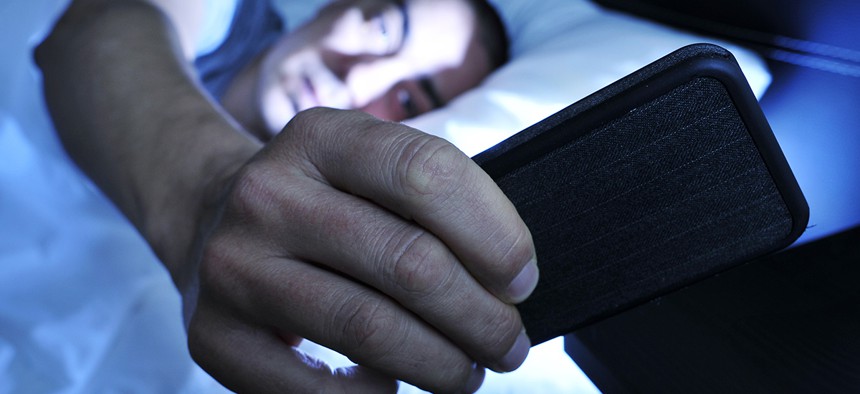If You Can’t Stay Off Your Phone Before Bed, These Gadgets Will Make Sure Your Sleep Isn’t Ruined

nito/Shutterstock.com
With growing awareness of blue light’s ill effects, more companies are now catering to health-conscious consumers with products that reduce their exposure to these wavelengths.
Those late nights tapping away at your smartphone may be more detrimental to your health than you’d expect.
Studies spanning over several decades have found a strong link between exposure to blue light—the kind that’s emitted by personal electronic devices such as computers, tablets, smartphones, and smartwatches—and disrupted sleep, which has been linked to an increased risk of cancer, obesity, and diabetes.
With growing awareness of blue light’s ill effects, more companies are now catering to health-conscious consumers with products that reduce their exposure to these wavelengths.
Amazon, the world’s largest retailer, just shone a giant spotlight on the issue this month when it released a software update bringing a virtual “Blue Shade” to some of its tablets. Its blue filter joins a growing catalog of products from electronic manufacturers, software companies, and eyewear makers.
Unnatural habitat
Blue light is naturally abundant during the day, and has been shown to boost attention, reaction time, and mood. But its exposure at night has the effect of throwing sleep cycles out of whack.
Research into blue light’s effect on sleep dates back to at least 1958, when J. Woodland Hastings and Beatrice M. Sweeney published a paper in Biological Bulletin finding that blue wavelengths have the strongest effect resetting the circadian rhythm of Gonyaulax polyedra, a type of bioluminescent marine microorganism. But the research “gathered dust for decades,” according to a 2010 article in the Environmental Health Perspectives.
In the 1990s, George Brainard, the director of the light research program at the Thomas Jefferson University, conducted more than 700 experiments over a period of seven years to study how different wavelengths of light regulate the production of melatonin, a hormone that helps the body regulate sleep-wake cycles. He and his team were surprised to learn that humans were most sensitive to blue wavelengths.
More studies poured in after, including one from Harvard in 2014 that found that people who read at night using a light-emitting e-reader took longer to fall asleep and wake up, produced less melatonin, and were less alert the next morning compared to a control group who read printed books.
These effects can be worrying given that an estimated 90% of Americans say they use an electronic device within an hour of bedtime multiple times a week. It’s hard to quantify how much blue light disturbs people’s sleep, but it does appear to have a more profound effect on teenagers because of the shift in circadian rhythms during adolescence.
From there, the link to more serious health issues relies primarily on existing sleep studies showing a correlation between such conditions and disrupted sleep—though not necessarily caused by blue light. For example, a study from Vanderbilt University in 2013 linked interrupted circadian rhythms to greater risks of obesity, diabetes, and heart disease. Another one from University Hospitals Case Medical Center in 2011 found that those who slept less than six hours a night had a nearly 50% increased risk of colon cancer.
What can we do?
The easiest solution is to get off your phone or tablet late in the evening. Harvard Medical School recommends avoiding electronic screens two to three hours before going to sleep. But for those who can’t or don’t want to, there are solutions to eliminate or mitigate blue light exposure.
Amazon’s Blue Shade is a new feature available on its Fire HD 10, Fire HD 8, and Fire tablets. By default, the feature (accessible via the swipe-down menu) masks the screen with a dull orange hue, though users can also fine-tune the colors under the device’s settings.
A software program called F.lux, available for computers as well as iPhones and iPads, can also help cut down on blue light exposure by adjusting the display based on the time of day. At night, the colors on the screen appear warmer.
There are also orange-tinted goggles available from various companies to wear at night while watching television or using a device with a bright screen. But the lenses, ranging from a light yellow to bright orange, are anything but subtle.
Japanese eyewear maker Jins has also been selling a line of blue-light filtering glasses called Jins PC since 2011. (It brought the product to the US earlier this year under the name Jins Screen.) The glasses cut down on blue light exposure by only 25%, but for that tradeoff, they look almost like an ordinary pair of glasses.
“We want to achieve good balance so you can see normally and be seen normally,” Jins corporate planning manager Ryosuke Kimura tells Quartz.
Still, there are some subtle differences between a pair of Jins Screen and regular glasses. The lenses reflect blue light when they’re in front of a bright screen (this isn’t obvious to the wearer unless he or she is looking at a mirror), and the resulting image has colors that are slightly warmer than normal. But because they can pass for regular glasses, they’re designed for desk workers who can wear them in and out of the office.
Like Amazon, Jins is using its line of blue light-filtering glasses to raise awareness of the issue. In June, the company sponsored the Blue Light Symposium in New York City, and one of the main objectives of the conference is to better understand the direct effect blue light has on people’s health beyond sleep.
“It’s very certain that blue light has a direct connection to the circadian rhythm,” Kimura says. “Now we’re focused on what kind of effect they can have on our bodies.”
(Image via nito/Shutterstock.com)
NEXT STORY: What Everybody Googled in 2015


